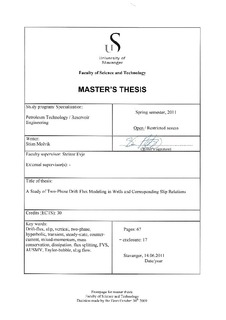| dc.contributor.author | Molvik, Stian | |
| dc.date.accessioned | 2011-10-28T13:57:05Z | |
| dc.date.available | 2011-10-28T13:57:05Z | |
| dc.date.issued | 2011 | |
| dc.identifier.uri | http://hdl.handle.net/11250/183303 | |
| dc.description | Master's thesis in Petroleum engineering | no_NO |
| dc.description.abstract | It was desired to investigate the two-phase drift-fl ux model's behavior in both steady-state and
transient settings and shed some light on required slip relations. A numerical MATLAB model of
the one-dimensional two-phase drift-fl ux model developed by Dr. Steinar Evje has been used to
simulate gas-liquid fl ow in a vertical pipe. Diff erent slip parameters have been tested, compliant
with the general formulation from Zuber and Findlay [22]. Optimized slip parameters from Shi
et al. [15] have been implemented in the numerical model, and simulation runs for both steady-
state and transient conditions are included. Ten steady-state simulations have been carried out,
matching the experimental holdup data very well with a root-mean square error of only 0.039.
The optimized slip parameters have then been directly applied in a transient setting, in which
a 17.8 dm3 slug is put at the bottom of a 10.9 m, 15.24 cm diameter pipe and allowed to migrate
towards the closed outlet, similar to what would happen in a kicking well. It is observed that
the optimized slip is not able to reproduce the typical Taylor bubble fl ow expected to occur in
such a setting, as the gas distribution of the slug was seen to spread over the length of the pipe.
As the gas is seen to accumulate at top, unphysical behavior is observed, and it is believed that
the slip model from Shi et al. causes the drift- flux model failing to remain hyperbolical. This
has given way for a desire to implement di fferent slip parameters able to reproduce more typical
Taylor-bubble behavior.
Basic slip parameters for slug fl ow and parameters for Taylor bubbles from Hibiki and Ishii [6]
have been implemented. Although the complexity of the Taylor bubble slip far outweighs that of
the simple slug flow slip, the results where found to be in good agreement with each other with
regards to gas distribution in the pipe. The slug flow slip was able to let the gas slug maintain
a maximum average gas volume fraction of a g;max = 0.79, while the Taylor bubble slip gave a
respectable average gas fraction of g;max = 0.82. Also, the Taylor-bubble-slip proved to increase
the overall rise velocity of the slug, allowing it to traverse the pipe at a somewhat higher velocity
than when using slug fl ow slip. | no_NO |
| dc.language.iso | eng | no_NO |
| dc.publisher | University of Stavanger, Norway | no_NO |
| dc.relation.ispartofseries | Masteroppgave/UIS-TN-IPT/2011; | |
| dc.subject | petroleumsteknologi | no_NO |
| dc.subject | reservoarteknologi | no_NO |
| dc.title | A study of two-phase drift-flux modeling in wells and corresponding slip relations | no_NO |
| dc.type | Master thesis | no_NO |
| dc.subject.nsi | VDP::Technology: 500::Rock and petroleum disciplines: 510::Petroleum engineering: 512 | no_NO |
